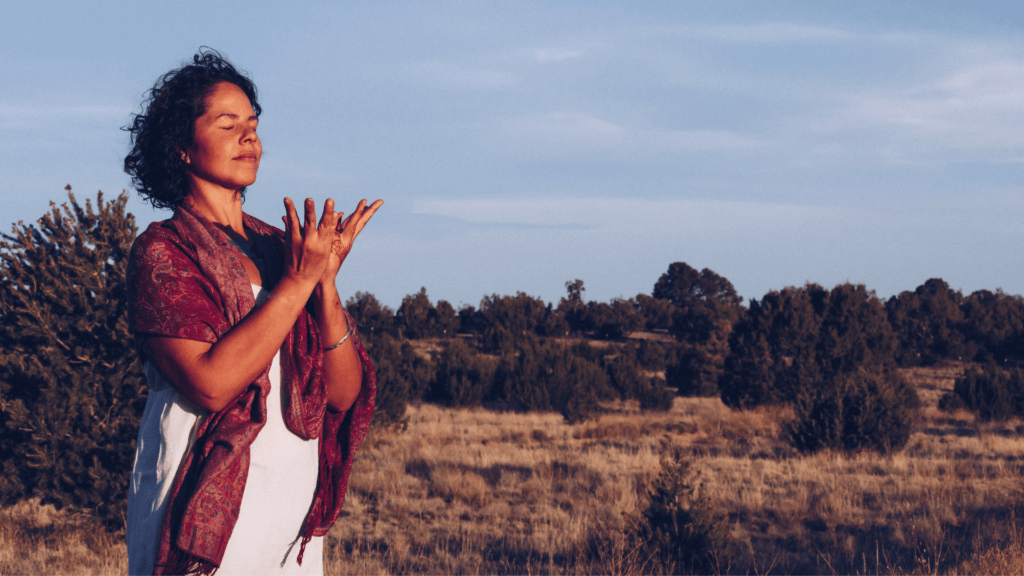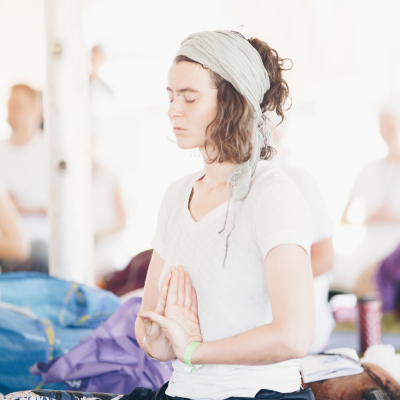Advice for the Yoga Journey
Getting Started on Your Yoga Journey
Stepping into the world of Kundalini Yoga for the first time can be a truly magical experience. But it can also be overwhelming! There’s a ton of practices to choose from, and many unique reasons why you might be interested in it in the first place.
If you’re here, maybe you’re looking to try yoga for the first time; maybe you’re familiar with other traditions but new to Kundalini; or maybe you’re wondering what it even means to “try yoga” at all. How do you find a practice that works for you? This section will guide you through some pointers to start up a practice that is enjoyable, sustainable, and gives you what you need.

What is a “Yoga Practice” Anyway?
There are many different yogic traditions, and each has its own standards and guidelines for what their practice consists of. In Kundalini Yoga, the most basic unit of practice is the kriya.
There are no rules about which kriyas you’re allowed to practice or which ones have to go together. You can practice any kriya that speaks to you. The only guideline is that each kriya should be practiced in its entirety in a single sitting in order to achieve the desired effect.
Practicing a kriya is great, but Kundalini Yoga is about more than just what happens on the yoga mat. It’s about bringing harmony and awareness to all aspects of our being, which includes how we eat, dress, communicate, interact, and show up in the world. That’s why in addition to all the wonderful kriyas you can practice, you will also find that Kundalini Yoga is full of lifestyle tools to support your well-being in your daily life.
As with kriya practice, there are no set requirements for what constitutes a yogic lifestyle, and no “minimum level” you must achieve to consider yourself a yogi. These are tools which can help cultivate a greater sense of awareness and wellbeing in your life, but which are nevertheless entirely optional. Part of cultivating the intention of a yogic practice is developing the self-awareness to choose the path that best supports your own needs, whether or not it matches your or anyone else’s ideas of what a yogic lifestyle should look like.
Getting Started
Kundalini Yoga has a lot to offer, and it can be really overwhelming at first. There is no “correct” way to begin, but if possible it is recommended to take a class and study with a certified teacher. This is a great way to get the experience of Kundalini Yoga in a supportive setting without having to wade through all the options yourself. There are many teachers in communities throughout North America and around the world. If a class is not available to you, or you prefer to get started on your own, start by trying out a few different things to see how they feel. Here are a two great options:
- You can start with this collection of Kundalini Yoga’s “Greatest Hits”
- This practical guide for creating a home experience with Kundalini Yoga includes helpful links to a number of kriyas and chants

We suggest you approach with an attitude of exploration and just start to see what some of these kriyas and lifestyle practices feel like for you. You may find that you naturally gravitate toward certain practices and don’t love others so much. For now, just allow this to be information you are learning about yourself. There’s no need to push yourself one way or another.
As you start to get a feel for the range of what Kundalini Yoga has to offer, you will likely reach a point where you feel you are ready for a little more consistency in your practice. A good place to start is to choose a single kriya or lifestyle practice that you are going to continue returning to in order to deepen your experience of it.
You can start by choosing one practice that resonates with you and try practicing it a few times a week, or every other day. This can allow you to experience a deepening relationship with a single practice while also allowing you the freedom to continue exploring. If you feel so inspired, you can also try a 40-day sadhana.
Sustaining Your Practice
As you continue with your practice, you will likely have times when you’re naturally inspired, and others when you wonder why you’re still doing this, or when life gets in the way and you find you’re not able to keep up as consistent a habit as you’d hoped. Here are some tips to help get past the bumps that come with starting anything new, and find a sustainable rhythm.
Reduce Friction
If this is a new habit for you, then it’s likely that your life is not automatically set up to accommodate it. It takes work to fit a new routine into your existing ones. The natural impulse of your momentum and your environment is probably not to do the new thing—it’s to do whatever you’ve been doing all along.
You can help combat this by proactively setting up your environment for success. Habit-formation experts say that whether we like it or not, we are all products of our environments. When we’re tired, stressed, or anything less than our best, most of us will gravitate toward the simplest option. The good news is that with a little creativity, you can set yourself up to make yoga the easiest choice.
Pick a yoga spot that you like, and make sure it’s easy to get to and has everything you need. If you need to move your coffee table out of the way anytime you want to do yoga, for example, you’re likely to start skipping days just because it’s too much effort. Instead, you could try having no coffee table for a week, and instead, keep your mat unrolled in the middle of your floor. This can disrupt your expectations of the space, and remind you that you would rather try some yoga than watch TV when you get home.
Start Small and Stay Flexible
Early in your yoga journey, it can be easy to get excited and carried away with trying too many things at once. As a result, it’s easy to become overwhelmed and revert back to doing nothing at all.
Therefore, try not to overcommit yourself (and be gentle if you find you’re able to do even less than your already-reduced expectations). Again, an attitude of exploration is helpful here. If you decide on day one that you’re going to do seventeen new things every day from now on, you’re likely to get frustrated very soon. Better to start with small changes, or to allow yourself the freedom to decide in a flexible way what you feel like doing today. Again, the goal is to support your wellbeing, and stressing that you’re not being healthy enough is not supportive to your wellbeing! Know that it will take some time before you start to feel settled into your new routines, and make sure you give yourself the freedom and self-kindness to be flexible.
Keep a Journal
One of the best things yoga can do for you is help to develop your self awareness. Make a habit of checking in with yourself before and after your practice, and throughout your day. As you do, honestly observe your actual experience (not just your expected experience). Keeping a journal is one technique that can help you to be more intentional with your observations, as well as give you a valuable log of how those experiences change over time and impact other areas of your life.
It’s normal not to always feel great doing yoga. Kriyas can bring subconscious patterns to the surface that are uncomfortable to confront. This doesn’t mean you are doing yoga wrong, it just shows you where you may have more work to do. Sometimes you will do a kriya and feel a blissful halo surrounding everything you do for the rest of your day. Sometimes you will do your practice and find that your day is now a long series of the world’s most irritating circumstances. Either way, wonderful! This is the beauty of continually returning to the practice, and finding what it has to offer today.
Keeping a journal through all this can help you see these ups and downs as part of a larger process and connect them to the rest of your practice journey.
Connect with Others
Finding a class or event near you can be a great way to join in community, meet others, connect, and grow inspiration for your practice. Taking a class can also give you the experience of Kundalini Yoga that you won’t necessarily get from written instructions. The teacher transmits and explains the subtle instructions and experience. Many people find that engaging and connecting with others is what takes their practice from a mild curiosity to a consistent pillar of support in their lives.
If you don’t have access to a community near you, you can also look for classes online, or join one of 3HO’s free online events.
Remember Why You’re Doing This
When you’re feeling discouraged, tired, or overwhelmed, connecting to your “why” can help keep you going. It can also help guide your focus when you’re confronted with too many choices and aren’t sure what to practice. Knowing that your goals and priorities will certainly shift over time, you can use them as a filter to decide where to focus your attention in a given moment.
Do you want to feel stronger in your physical body?
Maybe start by making sure you do one physical kriya each day, or twice a week. You could also add a couple easy-to-maintain eating habits, such as drinking yogi tea instead of coffee a couple times a week. Take the time to really notice how those things feel before adding on new obligations.
Are you looking for a deper connection with your spiritual self?
You may want to spend more time trying out more introspective meditations, or learn about how the Ten Bodies can give you a framework for interacting with all aspects of your self.
Do you love chanting and music as part of your practice?
Try celestial communication, or use the filters in the Practice Hub to show just those kriyas that include a mantra. You can also check out our Music Resources page to find more music.
Are you looking to address a particular complaint?
You can use the filters in our Practice Hub to focus just on practices that help address whatever it is you’re looking for – from pain in your back to digestive issues to help with overcoming addiction.
We hope you find an enriching new part of your life in Kundalini Yoga. 3HO is here to support your practice with web resources, online events, in-person events, and community discussion spaces!

Remember
Your experience is unique, as are the reasons that drew you to Kundalini Yoga in the first place. You don’t have to love the same things everyone else seems to love, or follow the same schedule, or choose the same core practices (though borrowing these from others initially can be a great way to try them on for yourself). You yourself are the only thing that is with you all the way from birth to death, so you’re the most important relationship you have. Whatever supports YOU in your overall wellbeing, that’s a perfect place to be.
What’s Next?
Read Practice Tips for Newcomers, from the 3HO Staff, a collection of helpful advice
Bookmark the Practice Hub, so you can search for the kriya you want, anywhere, anytime